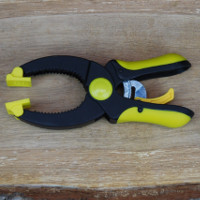Guide to clamps & vices
Different types of hand clamps & which ones suit what kind of project.

Introduction
What is a clamp?:
A clamp (sometimes referred to as a cramp) is a device that applies pressure to hold objects tightly in place onto a work surface, or to hold objects together.
This guide gives a brief description of different types of hand clamps and gives you an idea of which clamp to choose depending on your project.
A variety of clamps are available and used for many different purposes; in woodwork most are used as a temporary measure. Visit our clamp & vices section to see all the different clamps that we sell in our shop.
What you'll need
This activity has been provided by

Useful items from our shop
- Hobbyists Clamp
- F Clamps
- Clamps - Pack of 4 - 9cm
- Conker Clamp (Kids at Work)
- Vice - 50mm (Kids at Work)
Environmental Considerations
Consider the environmental impact of preparing, carrying out & completing this activity. Could this impact be reduced? Specific considerations for this activity could include:
Health & Safety Considerations
Follow your usual operating procedures and carry out appropriate risk benefit assessments.
Some considerations particular to this activity include:

Spring clamp:
Spring clamps tend to be small and are useful when working with smaller, delicate workpieces such as wooden discs. They can be used to hold small objects onto a work surface but are also very useful for holding two pieces together that are being glued.
Spring clamps have two jaws, two handles and a sprung pivot. Despite their small size they can apply a lot of pressure. They also require quite a bit of pressure to open so younger children will need support to use these clamps.
Spring clamps have plastic or rubber pads to protect the workpiece.

Ratchet clamp:
This is a clamp with a ratchet mechanism and one-finger quick release.
The ratchet mechanism allows for a stronger grip than a spring clamp.

G-clamp:
G-clamps are useful in woodwork projects. They have a fixed frame holding a threaded rod which attaches to a flat end/swivel shoe. The clamp is tightened by turning a T-handle attached to the rod.
The fixed frame means these clamps have a limited range (25-150mm) and a smaller jaw size compared to F-clamps.
Your choice of clamp will depend upon the size of your workpiece and workbench. The jaw size will be written in the product description.
The gripping surface of the frame and screw/swivel edge may cause indentations/marks in the wood you are working with. To avoid this use a scrap piece of wood as a protective layer between the clamp and the workpiece.

F-clamp:
F-clamps work in a similar way to G-clamps except that the frame is not fixed. One arm of the frame slides along a bar to give a far greater clamping range (up to 600mm) without requiring a longer threaded rod. The jaw size will be written in the product description.
On tightening, the sliding arm is securely held in place, as it torques onto ridges running along the bar.
The F-clamp is also tightened with a T-handle and, like the G-clamp, you will need to protect your workpiece from indentations using scrap wood.
A variation of the F-clamp is the Rapid Bar Clamp. It differs in that you must depress a button to move the sliding arm, and tighten it by squeezing a handle.

Conker clamp:
This is a hand-held clamp suitable for small items like conkers and acorns. The clamp allows you to hold the item safely using one hand whilst using a softwood hand drill or palm drill to make a hole.
Once the item is secured, rest the clamp on the work surface - hold the clamp with one hand and drill vertically down with the other.

Vice:
A vice or bench vice can be clamped or bolted to a workbench.
A vice allows workpieces to be quickly and easily clamped - in a vertical plane for the vice pictured - others may hold items horizontally. Some vices are quite small and portable.
Vices are ideal for tasks such as sawing, drilling and filing. The vice jaws can be adjusted to securely hold the object into place.
Activities to try using clamps:
Disclaimer: Muddy Faces cannot take any responsibility for accidents or damage that occurs as a result of following this activity.You are responsible for making sure the activity is conducted safely.
Key Features
- Age Range All Ages
- Duration Less than an hour
- Location Anywhere
- Season Any
- Time of Day Anytime
-
Categories:
Tool use & Traditional Crafts
tool guides



